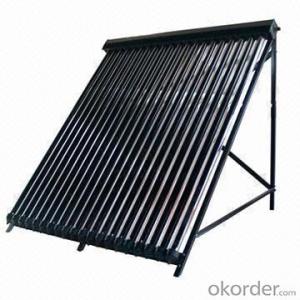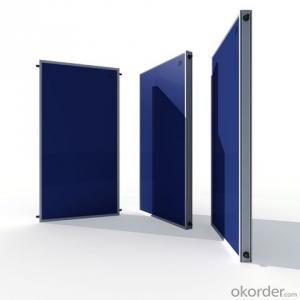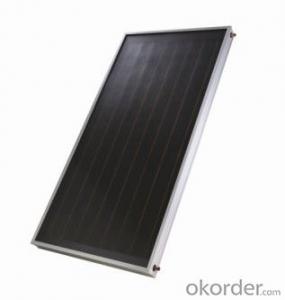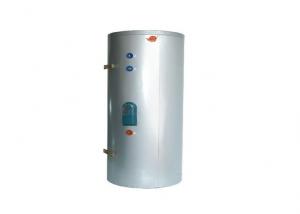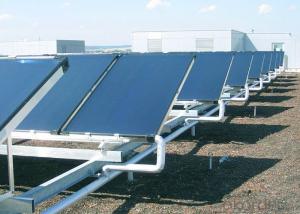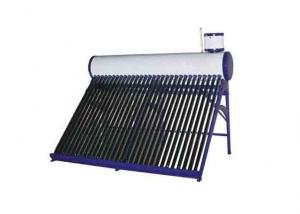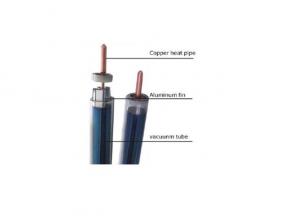Solar Collectors for Rooftop with Economical Vacuum Tube
- Loading Port:
- China main port
- Payment Terms:
- TT OR LC
- Min Order Qty:
- 5 set
- Supply Capability:
- 10000 set/month
OKorder Service Pledge
OKorder Financial Service
You Might Also Like
Specifications
manifold (inner) | red copper |
manifold (exterior) | aluminum alloy |
glass tube dimensions | 58mm * 1800mm |
daily efficiency | ≥55% |
heat preservation | 72 hours |
hail resistance | 25mm |
max pressure | 7 bar |
coating of vacuum tube | ALN/AIN-SS/CU |
heat pipe | anti-freezing > -35 degree |
certificate | Solar Keymark, EN12975,SRCC |
Serious Product
Models | L*W*H mm | Vacuum tube | Power output | Efficiency | Header mm | Frame | container loading 20FT/40HQ sets | Gross Weight kg |
SHC-8 | 1917*910*133 | 58*1800*8pcs | 939W | 0.668 | Φ35/1.0 | AL alloy | 185/445 | 27 |
SHC-10 | 1917*1130*133 | 58*1800*10pcs | 1189W | 159/385 | 33 | |||
SHC-12 | 1917*1350*133 | 58*1800*12pcs | 1440W | 149/358 | 40 | |||
SHC-15 | 1917*1680*133 | 58*1800*15pcs | 1815W | 120/290 | 49 | |||
SHC-18 | 1917*2010*133 | 58*1800*18pcs | 2191W | 100/242 | 59 | |||
SHC-20 | 1917*2230*133 | 58*1800*20pcs | 2442W | 87/210 | 66 | |||
SHC-22 | 1917*2450*133 | 58*1800*22pcs | 2692W | 83/202 | 72 | |||
SHC-24 | 1917*2670*133 | 58*1800*24pcs | 2943W | 77/188 | 79 |
Packaging & Delivery
Packaging Details: | Exporting Carton with big foaming protection |
Delivery Detail: | In 10-15 days |
Loading Quantity
Model | Tube | Tube Q.T.Y | Loading Q.T.Y/40HQ |
GSC15 | 58*1800mm | 15pcs | 315sets |
GSC18 | 58*1800mm | 18pcs | 265sets |
GSC20 | 58*1800mm | 20pcs | 248sets |
GSC22 | 58*1800mm | 22pcs | 225sets |
GSC25 | 58*1800mm | 25pcs | 200sets |
GSC30 | 58*1800mm | 30pcs | 168sets |
Principle of solar collector:
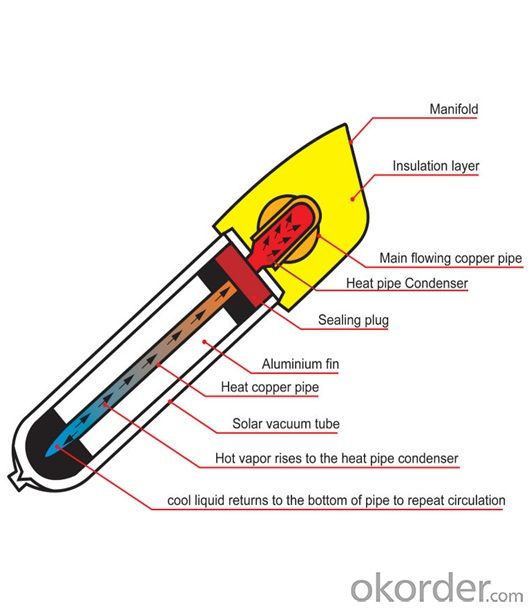

Solar collector details
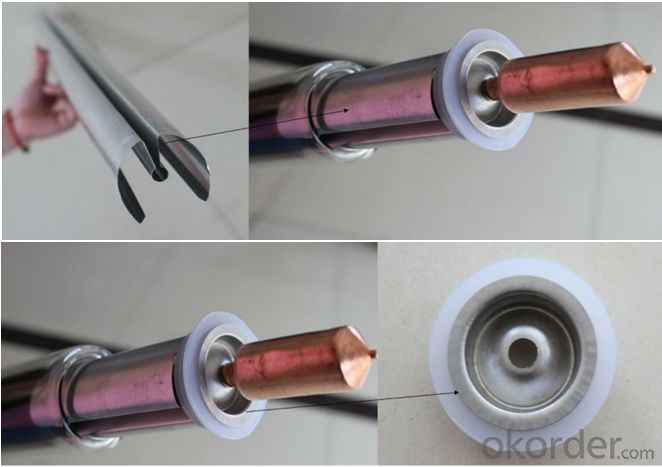

- Q:Can solar collectors be used for heating fire stations?
- Yes, solar collectors can be used for heating fire stations. Solar thermal systems can provide heat for water and space heating needs, reducing reliance on traditional heating systems and minimizing energy costs. However, the feasibility and effectiveness of using solar collectors will depend on factors such as the available roof space, local climate, and the heating demand of the fire station.
- Q:What is the effect of snow on solar collectors?
- The effect of snow on solar collectors is that it reduces or blocks the amount of sunlight reaching the surface of the collectors, thereby decreasing their efficiency in generating electricity or heat.
- Q:What is the energy payback time for a solar collector?
- The energy payback time for a solar collector refers to the length of time it takes for the energy savings gained from using the solar collector to offset the energy that was initially required to manufacture, install, and maintain the collector. This time period varies depending on factors such as the type of solar collector, its efficiency, geographical location, and the energy mix used during its production. On average, the energy payback time for a solar collector ranges from 1 to 4 years.
- Q:Can solar collectors be used for heating recreational vehicles and boats?
- Yes, solar collectors can be used to heat recreational vehicles and boats. Solar thermal systems can be installed on these vehicles to capture sunlight and convert it into heat, which can then be used for space heating or hot water heating purposes. This renewable energy source is environmentally-friendly, reduces reliance on traditional fuel sources, and can provide cost savings in the long run.
- Q:Are solar collectors affected by hail or other severe weather conditions?
- Yes, solar collectors can be affected by hail or other severe weather conditions. Hail can cause physical damage to the collectors, such as cracks or dents on the surface, which can impair their performance. Other severe weather conditions like strong winds or heavy snowfall can also potentially damage or dislodge the collectors. However, proper design, installation, and use of protective measures can minimize the impact of these weather conditions on solar collectors.
- Q:Can solar collectors be used for generating electricity on factories?
- Yes, solar collectors can definitely be used for generating electricity on factories. Solar collectors, also known as solar panels or photovoltaic (PV) panels, convert sunlight into electricity through the photovoltaic effect. This means that when sunlight hits the solar panels, it excites the electrons in the panel’s semiconductor material, generating an electric current. Factories typically have large rooftops or open spaces that can be utilized to install solar collectors. These solar panels can be connected to the factory's electrical system, allowing the generated electricity to be used directly in the factory's operations. By using solar collectors to generate electricity, factories can reduce their dependence on traditional energy sources like fossil fuels, thereby reducing their carbon footprint and energy costs. Moreover, solar collectors can also be combined with energy storage systems to store excess electricity generated during the day for use during non-sunlight hours. This enables factories to have a consistent and reliable source of electricity, even during nighttime or cloudy days. In addition to the environmental benefits, utilizing solar collectors for electricity generation can also bring financial advantages to factories. Many countries offer various incentives, such as tax credits, grants, or feed-in tariffs, to encourage the adoption of renewable energy technologies. These incentives can help offset the initial installation costs and provide a return on investment over time. Overall, solar collectors are a viable and sustainable option for generating electricity on factories. They offer a clean and renewable energy source, reduce carbon emissions, and can provide financial benefits. By embracing solar technology, factories can contribute to a greener future while also improving their own energy efficiency and cost-effectiveness.
- Q:Can solar collectors be used in areas with limited access to insurance coverage?
- Yes, solar collectors can be used in areas with limited access to insurance coverage. While insurance coverage is always recommended to protect against potential risks and damages, it is not a requirement for installing and using solar collectors. These systems can still provide renewable energy benefits in areas where insurance coverage may be limited or unavailable.
- Q:Can solar collectors be used in combination with water desalination systems?
- Water desalination systems can be combined with solar collectors for an effective solution. By harnessing solar energy, desalination systems can convert saltwater into freshwater by eliminating salt and impurities. Solar collectors, such as solar panels or solar thermal collectors, provide the necessary power for the desalination process. This combination offers various benefits. Firstly, solar energy is a clean and renewable power source, making the desalination process more environmentally friendly. Secondly, integrating solar collectors into existing desalination systems reduces reliance on fossil fuels and cuts operational costs. Moreover, solar-powered desalination systems are particularly advantageous in remote or off-grid areas with limited access to electricity. In conclusion, the combination of solar collectors and water desalination systems provides a sustainable and efficient solution to the increasing global water scarcity problem.
- Q:Can solar collectors be used for heating train stations?
- Yes, solar collectors can be used for heating train stations. Solar thermal collectors can be installed on rooftops or adjacent to train stations to harness the sun's energy and convert it into heat. This heat can then be used for space heating within the station, contributing to a more sustainable and energy-efficient heating system.
- Q:Flat solar collector how, flat solar collector working principle introduced
- The installation of the system search should ensure safety and functionality while taking into account the combination with the building.
1. Manufacturer Overview |
|
|---|---|
| Location | |
| Year Established | |
| Annual Output Value | |
| Main Markets | |
| Company Certifications | |
2. Manufacturer Certificates |
|
|---|---|
| a) Certification Name | |
| Range | |
| Reference | |
| Validity Period | |
3. Manufacturer Capability |
|
|---|---|
| a)Trade Capacity | |
| Nearest Port | |
| Export Percentage | |
| No.of Employees in Trade Department | |
| Language Spoken: | |
| b)Factory Information | |
| Factory Size: | |
| No. of Production Lines | |
| Contract Manufacturing | |
| Product Price Range | |
Send your message to us
Solar Collectors for Rooftop with Economical Vacuum Tube
- Loading Port:
- China main port
- Payment Terms:
- TT OR LC
- Min Order Qty:
- 5 set
- Supply Capability:
- 10000 set/month
OKorder Service Pledge
OKorder Financial Service
Similar products
New products
Hot products
Hot Searches
Related keywords
